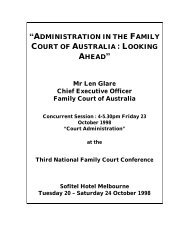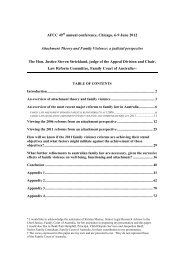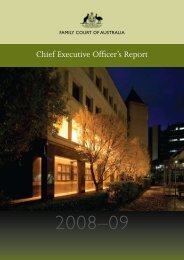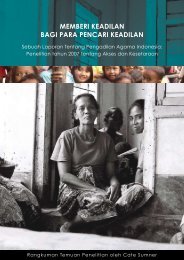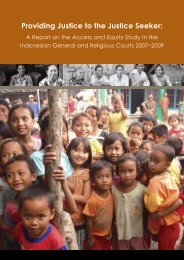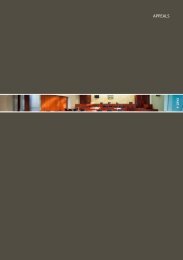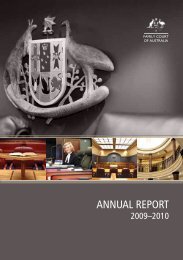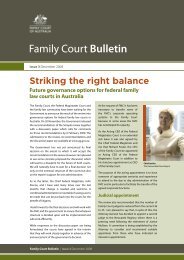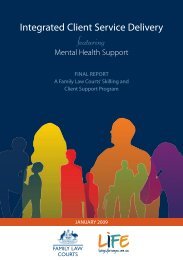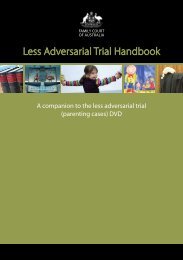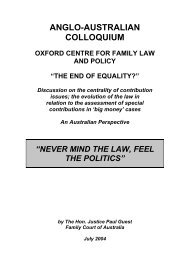View Part 2 - Overview of the Court (PDF Size - 305 KB)
View Part 2 - Overview of the Court (PDF Size - 305 KB)
View Part 2 - Overview of the Court (PDF Size - 305 KB)
- No tags were found...
You also want an ePaper? Increase the reach of your titles
YUMPU automatically turns print PDFs into web optimized ePapers that Google loves.
<strong>Overview</strong> <strong>of</strong> <strong>the</strong> court<strong>Part</strong> 2
<strong>Overview</strong> <strong>of</strong> <strong>the</strong> court <strong>Part</strong> 210Family <strong>Court</strong> <strong>of</strong> Australia Annual Report 2006–2007Back to contents page
GENERAL OVERVIEWThe Family <strong>Court</strong> <strong>of</strong> Australia, through its specialist judges and staff, helps Australiansresolve <strong>the</strong>ir most complex family disputes.Presently, <strong>the</strong> <strong>Court</strong> is funded to provide two outputs:Resolution (measured by mediated agreements and consent orders) andDetermination (measured by interim orders, final orders, appeals and divorces).The resolution output continues to reflect <strong>the</strong> fact that, in <strong>the</strong> past, <strong>the</strong> Family <strong>Court</strong>has invested significantly in resolving disputes through <strong>the</strong> work <strong>of</strong> its mediators (nowfamily consultants) and registrars. The Annual Report 2006-07, in particular <strong>the</strong> Reporton <strong>Court</strong> Performance in <strong>Part</strong> 3, continues to detail <strong>the</strong> <strong>Court</strong>’s progress against thosestated outputs during <strong>the</strong> reporting year.However, <strong>the</strong> function <strong>of</strong> <strong>the</strong> <strong>Court</strong> has evolved as a result <strong>of</strong> reforms to <strong>the</strong> Family LawAct and <strong>the</strong> wider family law system. These family law reforms enable <strong>the</strong> Family <strong>Court</strong>to focus its resources increasingly on <strong>the</strong> determination <strong>of</strong> <strong>the</strong> most complex familylaw disputes in Australia. The reforms to date have established 40 out <strong>of</strong> a proposed65 Family Relationship Centres and increased access to alternative family relationshipservices in <strong>the</strong> community. This began in June 2006 and continues. From 1 July 2007 itis mandatory to access <strong>the</strong>se services before a person can make a court application. Inaddition, <strong>the</strong> expansion <strong>of</strong> <strong>the</strong> Federal Magistrates <strong>Court</strong>’s capacity to manage <strong>the</strong> lesscomplex family law cases has continued. This change <strong>of</strong> focus for <strong>the</strong> <strong>Court</strong> has beenadvanced during 2006-07 with <strong>the</strong> implementation <strong>of</strong> <strong>the</strong> Less Adversarial Trial for allnew cases in <strong>the</strong> Family <strong>Court</strong> and <strong>the</strong> implementation <strong>of</strong> <strong>the</strong> Child Responsive Programduring 2007. The ongoing refinement <strong>of</strong> <strong>the</strong> Combined Registry with <strong>the</strong> FederalMagistrates <strong>Court</strong> has also contributed to this development.<strong>Part</strong> 2<strong>Overview</strong> <strong>of</strong> <strong>the</strong> courtThe Family <strong>Court</strong> <strong>of</strong> Australia’s place in <strong>the</strong> family law system is as Australia’s specialistsuperior court in family law. Its purpose is to:determine cases with complex law, facts and parties;cover specialised areas, such as applications pursuant to <strong>the</strong> Hague Conventionon International Child Abduction, special medical procedures, and internationalrelocation; andprovide national coverage as <strong>the</strong> appellate court in family law matters.Back to contents pageFamily <strong>Court</strong> <strong>of</strong> Australia Annual Report 2006–200711
GOVERNANCEThe Chief Justice is responsible for managing <strong>the</strong> administrative affairs <strong>of</strong> <strong>the</strong> <strong>Court</strong>(section 38A Family Law Act 1975) assisted by <strong>the</strong> Chief Executive Officer (section 38B).<strong>Overview</strong> <strong>of</strong> <strong>the</strong> court <strong>Part</strong> 2The Chief Executive Officer’s powers are broad (section 38D), although subject todirections from <strong>the</strong> Chief Justice (section 38D(3)). The Chief Executive Officer holds<strong>the</strong> responsibilities and powers <strong>of</strong> an agency head under Commonwealth financialmanagement and public service legislation. By delegation from <strong>the</strong> Chief Justice,Regional Coordinating Judges assist in administering judicial functions in particularareas, such as case management.There is a balance <strong>of</strong> powers and responsibilities across management and <strong>the</strong> judiciary.The Chief Justice has maintained a collegiate style <strong>of</strong> governance and <strong>the</strong> judges meetonce or twice yearly in plenary. In addition, judges and staff participate in a number <strong>of</strong>committees that develop policies across a range <strong>of</strong> matters.The Chief Justice’s Policy Advisory Committee (CJPAC), which meets quarterly, advises<strong>the</strong> Chief Justice on policy matters. The Rules Committee also meets quarterly.The <strong>Court</strong> also has a number <strong>of</strong> o<strong>the</strong>r standing committees that generally meet bytelephone on a regular basis or as required, out <strong>of</strong> court hours. They are:Costs CommitteeCultural Diversity CommitteeElectronic Benchbook CommitteeFamily Violence CommitteeInformation and Communication Technology CommitteeJudgment Publication CommitteeLaw Reform CommitteeLibrary CommitteeNational Case Management Judicial CommitteeNational Magellan Stakeholder CommitteePr<strong>of</strong>essional Development CommitteeProperty Management CommitteeResearch and Ethics CommitteeSelf Represented Litigants CommitteeStrategic Communications CommitteeDuring <strong>the</strong> year <strong>the</strong>re was also an ad hoc committee which provided policy advice to<strong>the</strong> Chief Justice in relation to case management following <strong>the</strong> decision to implement<strong>the</strong> less adversarial trial model to all matters in <strong>the</strong> <strong>Court</strong>. The work <strong>of</strong> <strong>the</strong> CaseManagement Policy and Procedure Committee is expected to be completed before <strong>the</strong>end <strong>of</strong> 2007.12Family <strong>Court</strong> <strong>of</strong> Australia Annual Report 2006–2007Back to contents page
More information on any significant outputs from <strong>the</strong>se committees appears inAppendix 2.The <strong>Court</strong> Management Group, comprising <strong>the</strong> Chief Executive Officer and o<strong>the</strong>rsenior executive staff, is responsible for implementing <strong>the</strong> <strong>Court</strong>’s strategic direction.Operational management is devolved to registries where regional registry managerswork closely with judges to deliver court services to families in dispute.In 2004-05 <strong>the</strong> Family Law <strong>Court</strong>s Board was established, comprising <strong>the</strong> Chief Justice<strong>of</strong> <strong>the</strong> Family <strong>Court</strong>, <strong>the</strong> Chief Federal Magistrate <strong>of</strong> <strong>the</strong> Federal Magistrates <strong>Court</strong> and<strong>the</strong> Chief Executive Officers <strong>of</strong> each court. This Board oversees <strong>the</strong> coordination andmanagement, and makes decisions about <strong>the</strong> shared arrangements between <strong>the</strong> twocourts.FINANCIAL OVERVIEWThe Family <strong>Court</strong> <strong>of</strong> Australia is a prescribed agency under <strong>the</strong> Financial Managementand Accountability Act 1997.The <strong>Court</strong>’s 2006-07 budget, as published in <strong>the</strong> Portfolio Additional EstimatesStatements, was $139.1m. Figure 2.1 (below) provides a fur<strong>the</strong>r breakdown <strong>of</strong> <strong>the</strong>budget which indicates that <strong>the</strong> <strong>Court</strong> has a significant component <strong>of</strong> fixed costs (54%)relating to property, judicial <strong>of</strong>ficers and support and depreciation.<strong>Part</strong> 2<strong>Overview</strong> <strong>of</strong> <strong>the</strong> courtThe <strong>Court</strong> has reported a small loss <strong>of</strong> $0.159m for <strong>the</strong> 2006-07 financial year comparedto a break-even result forecast in <strong>the</strong> Portfolio Budget Statement and Portfolio BudgetAdditional Estimates.The <strong>Court</strong> currently provides resources free <strong>of</strong> charge to <strong>the</strong> FMC in accordance withsections 90, 92 and 99 <strong>of</strong> <strong>the</strong> Federal Magistrates Act 1999. These free resources include<strong>the</strong> work <strong>of</strong> court staff for <strong>the</strong> FMC and accommodation, including access to courtrooms. The <strong>Court</strong> estimates that <strong>the</strong> cost <strong>of</strong> resources provided free <strong>of</strong> charge to <strong>the</strong>FMC during 2006-07 was $16.46m.In addition, <strong>the</strong> <strong>Court</strong> provides fur<strong>the</strong>r shared services, including informationtechnology services, accommodation, <strong>the</strong> work <strong>of</strong> court staff (family consultants,registrars and registry services) and <strong>the</strong> related depreciation and amortisation.The <strong>Court</strong> is currently working with <strong>the</strong> FMC to agree <strong>the</strong> costs <strong>of</strong> shared services in orderto transfer <strong>the</strong> resources or an agreed amount to <strong>the</strong> FMC. This will enable accountabilityand control <strong>of</strong> those resources to more appropriately reside with <strong>the</strong> FMC.An initial transfer <strong>of</strong> $1.575m, for 100 per cent FMC court space usage, occurred in <strong>the</strong>2007–08 Federal Budget with <strong>the</strong> balance to occur as part <strong>of</strong> <strong>the</strong> 2008–09 FederalBudget.The chart following indicates those services which are presently being provided free <strong>of</strong>charge to <strong>the</strong> FMC.Back to contents pageFamily <strong>Court</strong> <strong>of</strong> Australia Annual Report 2006–200713
Figure 2.1 Chart <strong>of</strong> Family <strong>Court</strong> Expenditure & Shared with FMCVariableFixedShared Resources<strong>Overview</strong> <strong>of</strong> <strong>the</strong> court <strong>Part</strong> 2CorporateSupport, 3%CorporateOverheads, 6%InformationTechnologyServices, 6%ClientServices, 19%FamilyConsultants, 7%Registrars, 5%LegendJudges &SupportJudicialRegistrars &SupportDepreciationPropertyRegistrarsFamilyConsultantsClient ServicesCorporateSupportInformationTechnologyServicesCorporateOverheadsJudges &Support, 21%JudicialRegistrars &Support, 1%Depreciation,5%Property, 27%CorporateSupportCorporateOverheadsInformationTechnologyServicesClientServicesFamilyConsultantsRegistrarsAll employee and supplier expenses directly attributed to judges and <strong>the</strong>ir support staffAll employee and supplier expenses directly attributed to Judicial Registrars and <strong>the</strong>irsupport staffAll depreciation, amortisation and o<strong>the</strong>r expenses associated with asset movementsLease Rentals for Commonwealth Law <strong>Court</strong>s and Leased Premises, and all PropertyOperating Expenses (such as cleaning, energy, repairs and maintenance, andmanagement fees) associated with <strong>the</strong>se premises.All employee and supplier expenses directly attributed to RegistrarsAll employee and supplier expenses directly attributed to Family ConsultantsAll employee and supplier expenses directly attributed to Client Service staffJudges &SupportJudicialRegistrars &SupportDepreciationAll employee and supplier expenses directly attributed to Finance, Human Resources,Property Services, Contract Services, and <strong>the</strong> Chief Executive OfficerPropertyAll employee and supplier expenses directly attributed to <strong>the</strong> provision <strong>of</strong> InformationTechnology ServicesWorkers Compensation and Com Cover Insurance Premiums, Fringe Benefit TaxExpenditure, ComSuper Management Fees, Legal and Audit Fees, Corporate SalaryOverheads attributed to Registry Management, Corporate Support and IT Services Staff,and Expenditure related to project activity in <strong>the</strong> <strong>Court</strong> (some <strong>of</strong> which is externallyfunded).14Family <strong>Court</strong> <strong>of</strong> Australia Annual Report 2006–2007Back to contents page
INITIATIVES OF THE FAMILY COURT AND THE FEDERALMAGISTRATES COURTCOMBINED REGISTRY PROGRAMThe Combined Registry Project <strong>of</strong> <strong>the</strong> Family <strong>Court</strong> and <strong>the</strong> FMC commenced in July2004 to simplify access to <strong>the</strong> family law system.The five key objectives <strong>of</strong> <strong>the</strong> project are to:reduce confusion for clients through a single point <strong>of</strong> filing and through introduction<strong>of</strong> a common form;reduce <strong>the</strong> number <strong>of</strong> times clients need to attend court and ensure each event addsvalue and progresses <strong>the</strong> case towards a conclusion;provide earlier access to a judicial <strong>of</strong>ficer;provide a single entry point within <strong>the</strong> FMC for much <strong>of</strong> <strong>the</strong> filing; andprovide services that make <strong>the</strong> process more timely, including improving <strong>the</strong>community perception <strong>of</strong> both <strong>Court</strong>s.Key achievements <strong>of</strong> <strong>the</strong> project during 2006-07 include:The Combined Initiating Application commenced as a pilot on 8 January 2007and concluded on 30 June 2007, following many months <strong>of</strong> consultation between<strong>the</strong> <strong>Court</strong>s. An evaluation <strong>of</strong> <strong>the</strong> application was conducted and a report will beprovided to <strong>the</strong> Family Law <strong>Court</strong>s Board in late 2007.A single hard copy file cover was introduced on 1 January 2007, allowing parties t<strong>of</strong>ile all documents toge<strong>the</strong>r regardless <strong>of</strong> in what court <strong>the</strong> matter is listed. Casetrack,<strong>the</strong> case management system for both <strong>Court</strong>s, provides <strong>the</strong> required singlenumbering regime. The changes enable <strong>Court</strong> staff and <strong>the</strong> judiciary to view andwork on applications from both <strong>Court</strong>s without changing jurisdictions.A Streaming Model is to be piloted in <strong>the</strong> Adelaide registry from 2 July 2007. Themodel anticipates <strong>the</strong> filing <strong>of</strong> most family law applications in <strong>the</strong> FMC and setsout <strong>the</strong> process to be trialled in managing intake <strong>of</strong> applications and transfers to<strong>the</strong> Family <strong>Court</strong>. The model was <strong>the</strong> outcome <strong>of</strong> a workshop involving AdelaideFamily <strong>Court</strong> judges, federal magistrates, representatives from <strong>the</strong> legal pr<strong>of</strong>ession,<strong>the</strong> Attorney-General’s Department and <strong>Court</strong> staff. A joint steering committee hasbeen established to oversee <strong>the</strong> implementation and <strong>the</strong> conduct <strong>of</strong> <strong>the</strong> pilot. Thesteering committee reports to <strong>the</strong> Family Law <strong>Court</strong>s Board.The updated and improved intranet site for <strong>the</strong> Family <strong>Court</strong>, and <strong>the</strong> new site for <strong>the</strong>FMC, were launched as part <strong>of</strong> this program in October 2006. Development involvedextensive consultation with <strong>the</strong> judiciary and staff <strong>of</strong> each <strong>Court</strong>.<strong>Part</strong> 2<strong>Overview</strong> <strong>of</strong> <strong>the</strong> courtBack to contents pageFamily <strong>Court</strong> <strong>of</strong> Australia Annual Report 2006–200715
NATIONAL ENQUIRY CENTREIn order to provide a better telephone and email service to clients contacting <strong>the</strong> Family<strong>Court</strong> and <strong>the</strong> FMC, <strong>the</strong> National Enquiry Centre (NEC) was established in April 2006 aspart <strong>of</strong> <strong>the</strong> Combined Registry Program. The NEC is able to answer many queries andonly diverts calls to a registry where necessary. This reduces <strong>the</strong> number <strong>of</strong> callerstransferred which only occurs if <strong>the</strong>y need ano<strong>the</strong>r specific service.<strong>Overview</strong> <strong>of</strong> <strong>the</strong> court <strong>Part</strong> 2The NEC aims to provide a quality service to clients. Its service benchmarks are:80% <strong>of</strong> calls are answered within 90 seconds,less than 5% <strong>of</strong> calls abandoned,less than 10% <strong>of</strong> calls transferred to a Family Law registry,100% <strong>of</strong> emails answered within 7 days, and100% <strong>of</strong> requests for divorce certificates processed and sent within 3 working days<strong>of</strong> receipt.Of <strong>the</strong> calls received by <strong>the</strong> NEC only 8% require a transfer to a Family Law registry,approximately 5% are referred to <strong>the</strong> Family Relationships Advice Line or o<strong>the</strong>r externalservice provider, 1% are transferred to <strong>the</strong> Federal <strong>Court</strong> <strong>of</strong> Australia, and 3% require <strong>the</strong>assistance <strong>of</strong> o<strong>the</strong>r <strong>Court</strong>s, eg. local courts and <strong>the</strong> Family <strong>Court</strong> <strong>of</strong> Western Australia.The Manager National Enquiry Centre at workThe effectiveness <strong>of</strong> <strong>the</strong> NEC was evaluatedby an external consultant during 2006-07. Thereview concluded that <strong>the</strong> centre provides a costeffective, reliable, timely and client focussed firstpoint <strong>of</strong> electronic contact for clients <strong>of</strong> both<strong>Court</strong>s. The evaluation fur<strong>the</strong>r illustrated thatthis services provides a highly visible, nationallyintegrated and seamless telephone service,ensures uniformity <strong>of</strong> approach and consistencyin response to general family law telephone andemail enquiries. 11 See <strong>Part</strong> 6 for more information on <strong>the</strong> evaluation outcomes.16Family <strong>Court</strong> <strong>of</strong> Australia Annual Report 2006–2007Back to contents page
INITIATIVES OF THE FAMILY COURT, FEDERAL COURT ANDFEDERAL MAGISTRATES COURTONLINE ACCESS BY LAW FIRMS (Commonwealth <strong>Court</strong>s Portal)The Commonwealth <strong>Court</strong>s Portal is a joint project <strong>of</strong> <strong>the</strong> Family <strong>Court</strong>, Federal <strong>Court</strong>,and <strong>the</strong> FMC. The vision <strong>of</strong> <strong>the</strong> ‘Portal’ is to provide <strong>the</strong> external community, lawyers andlitigants with a single entry point or ‘gateway’ to a broad range <strong>of</strong> court services. ThePortal delivers access for lawyers and litigants to <strong>the</strong>ir own court records in Casetrack bylogging on using a single secure ID and password. They can obtain information about<strong>the</strong> cases in which <strong>the</strong>ir firm is involved. This includes:a list <strong>of</strong> all documents filed in <strong>the</strong>ir matter (including date filed and by whom <strong>the</strong>document was filed);details <strong>of</strong> past and future court dates;details <strong>of</strong> court outcomes and orders made; anda list <strong>of</strong> all matters in <strong>the</strong> court for <strong>the</strong>ir firm.Law firms can internally manage access permission for <strong>the</strong>ir staff and <strong>the</strong> barristers <strong>the</strong>ybrief. Each staff member can <strong>the</strong>n access <strong>the</strong> specific files <strong>the</strong>y need. The Portal allowsusers to keep track <strong>of</strong> <strong>the</strong>ir own case load using a ‘bookmarks’ feature, and check allup-coming events in a diary view.<strong>Part</strong> 2<strong>Overview</strong> <strong>of</strong> <strong>the</strong> courtThe three Commonwealth jurisdictions have adopted a common case managementsystem, Casetrack, which has facilitated taking this next collaborative step. The projectwill start in August 2007.INITIATIVES OF THE FAMILY COURTCHILDREN’S CASES PROGRAM /LESS ADVERSARIAL TRIALDivision 12A <strong>of</strong> <strong>Part</strong> VII <strong>of</strong> <strong>the</strong> Family Law Act commenced on 1 July 2006, enabling whatwas <strong>the</strong> Children’s Cases Program (CCP) to become <strong>the</strong> Family <strong>Court</strong>’s model for a LessAdversarial Trial (LAT) to be applied to all new ‘child related proceedings’ in <strong>the</strong> Family<strong>Court</strong>, without <strong>the</strong> need for consent <strong>of</strong> <strong>the</strong> parties. 2In September 2006 a national judges meeting endorsed <strong>the</strong> application <strong>of</strong> <strong>the</strong> LATapproach to all new family law cases (including financial cases), to commence before<strong>the</strong> end <strong>of</strong> 2007. The required new case management pathway to implement thisdecision is being developed by <strong>the</strong> <strong>Court</strong>’s Case Management Policy and ProcedureCommittee for consideration <strong>of</strong> all judges in August 2007. The LAT will <strong>the</strong>n become <strong>the</strong>way in which <strong>the</strong> Family <strong>Court</strong> <strong>of</strong> Australia conducts all cases.2 See <strong>Part</strong> 6 for information on evaluations <strong>of</strong> <strong>the</strong> CCP.Back to contents pageFamily <strong>Court</strong> <strong>of</strong> Australia Annual Report 2006–200717
<strong>Overview</strong> <strong>of</strong> <strong>the</strong> court <strong>Part</strong> 2From <strong>the</strong> launch <strong>of</strong> Finding a Better WayCHILD RESPONSIVE PROGRAMIn recognition <strong>of</strong> <strong>the</strong> significance <strong>of</strong> <strong>the</strong> reformsthat LAT represents <strong>the</strong> <strong>Court</strong> published Findinga Better Way: A bold departure from <strong>the</strong> traditionalcommon law approach to <strong>the</strong> conduct <strong>of</strong> legalproceedings in April 2007. This publication is anaccount <strong>of</strong> <strong>the</strong> decisions taken to commence <strong>the</strong>pilot and <strong>the</strong> reasons for <strong>the</strong>m, as well as <strong>of</strong> <strong>the</strong>experience <strong>of</strong> CCP. It also marked <strong>the</strong> conclusion<strong>of</strong> <strong>the</strong> first stage <strong>of</strong> <strong>the</strong> reform process — from<strong>the</strong> vision through to implementation — andcommencement <strong>of</strong> <strong>the</strong> second stage, putting itinto daily practice.In response to <strong>the</strong> changes to <strong>the</strong> family law framework, particularly <strong>the</strong> establishment<strong>of</strong> Family Relationship Centres and <strong>the</strong> introduction <strong>of</strong> compulsory dispute resolutionbefore filing, <strong>the</strong> <strong>Court</strong> has changed <strong>the</strong> role <strong>of</strong> its family consultants. This is in line with<strong>the</strong> <strong>Court</strong>’s aim to provide a quality service which directly supports judicial decisionmaking,without duplicating services in <strong>the</strong> community. The <strong>Court</strong> has developedand tested a new model <strong>of</strong> family consultants working with child disputes, called <strong>the</strong>Child Responsive Program (CRP). Each case has a family consultant allocated to it.This provides continuity <strong>of</strong> family consultant through to trial and post-trial follow upand referral, where this is required. 3 CRP aims to include children early in <strong>the</strong> process,providing an opportunity to put forward <strong>the</strong>ir views and to focus parents on <strong>the</strong>irneeds. CRP is designed to integrate and align with less adversarial (child related) trialproceedings and to enable what occurs during <strong>the</strong> program to be admissible in court.The CRP provides <strong>the</strong> parties with <strong>the</strong> following:Intake and assessment meeting;Child and family conference with potential for child involvement, depending on <strong>the</strong>family consultant’s assessment;Selective settlement meeting;Oral report to <strong>the</strong> <strong>Court</strong> on first day <strong>of</strong> trial, if <strong>the</strong> matter has not settled;A Full Family Report if required; andPost orders follow up.Following <strong>the</strong> successful pilot in Melbourne and <strong>the</strong> evaluation by Dr Jennifer McIntosh,CRP was implemented in selected rural and regional registries, including Cairns,Townsville, Canberra, Dubbo, Hobart, Launceston and Lismore.3 An evaluation was designed and conducted by Dr. Jenn McIntosh (Child Responsive Program Evaluation Report,McIntosh & Long, September, 2006). See <strong>Part</strong> 6 for more information on <strong>the</strong> outcomes <strong>of</strong> this evaluation.18Family <strong>Court</strong> <strong>of</strong> Australia Annual Report 2006–2007Back to contents page
Following <strong>the</strong> success <strong>of</strong> <strong>the</strong> CRP pilot, <strong>the</strong> <strong>Court</strong> received additional funding from <strong>the</strong>Government in <strong>the</strong> 2007-08 Budget to implement <strong>the</strong> program nationally. The CRP willbe implemented throughout <strong>the</strong> <strong>Court</strong> in 2007-08.MAGELLANThe Magellan project pilot commenced in <strong>the</strong> Melbourne registry <strong>of</strong> <strong>the</strong> Family <strong>Court</strong> inmid 1998 and has now been implemented in all States and Territories. In NSW, however,it is limited (by direction from <strong>the</strong> Department <strong>of</strong> Children’s Services) to certainpostcodes in <strong>the</strong> South West Sydney area.Magellan involves special case management <strong>of</strong> cases in which <strong>the</strong>re are seriousallegations <strong>of</strong> sexual or physical abuse <strong>of</strong> a child. Once a Magellan case is identifiedit is managed by a designated small team consisting <strong>of</strong> a judge, registrar and familyconsultant. Magellan case management relies on a collaborative and highly coordinatedset <strong>of</strong> processes and procedures. A crucial aspect is strong inter-agency coordination,in particular with State and Territory child protection agencies, which ensures thatproblems are dealt with efficiently and that information sharing is <strong>of</strong> high quality. Anindependent children’s lawyer is appointed in every Magellan case.As a result <strong>of</strong> <strong>the</strong> legislative changes which commenced on 1 July 2006, <strong>the</strong> Family<strong>Court</strong> introduced a prescribed (mandatory) form to be used in two situations. One,when allegations <strong>of</strong> child abuse or risk <strong>of</strong> child abuse are made and a prescribed childwelfare authority must be notified <strong>of</strong> <strong>the</strong> allegations (Section 67Z <strong>of</strong> <strong>the</strong> Family Law Act1975). The o<strong>the</strong>r when a person alleges that <strong>the</strong>re has been abuse <strong>of</strong> a child, or familyviolence, or <strong>the</strong>re is a risk <strong>of</strong> abuse <strong>of</strong> a child or family violence, and <strong>the</strong> allegation isrelevant to whe<strong>the</strong>r <strong>the</strong> court should grant or refuse <strong>the</strong> application (Section 60K <strong>of</strong> <strong>the</strong>Family Law Act 1975). This form is a ‘trigger’ for identifying Magellan cases early in <strong>the</strong>court process.<strong>Part</strong> 2<strong>Overview</strong> <strong>of</strong> <strong>the</strong> courtThere have been a total <strong>of</strong> 734 Magellan cases since <strong>the</strong> introduction <strong>of</strong> this casemanagement process. 4MENTAL HEALTH SUPPORT, FAMILY VIOLENCE SCREENING AND CULTURALDIVERSITY (<strong>the</strong> Integrated Client Service Delivery Program)During <strong>the</strong> year <strong>the</strong> <strong>Court</strong> combined a number <strong>of</strong> client service related developmentactivities into <strong>the</strong> one Integrated Client Service Delivery Program (ICSDP). Each <strong>of</strong> <strong>the</strong>pre-existing projects was aiming to understand and better meet <strong>the</strong> needs <strong>of</strong> clients.At <strong>the</strong> same time <strong>the</strong> Government is pursuing a ‘whole <strong>of</strong> government’ approach topolicy and service delivery that emphasises integration between agencies and strongerpartnerships with <strong>the</strong> community sector. The aim <strong>of</strong> <strong>the</strong> ICSDP was to formally combine<strong>the</strong> pre-existing projects into a single, coordinated effort and to ensure that <strong>the</strong>y areincorporated and embedded into <strong>the</strong> <strong>Court</strong>’s core service delivery.4 See <strong>Part</strong> 6 for information on <strong>the</strong> external evaluation <strong>of</strong> this project.Back to contents pageFamily <strong>Court</strong> <strong>of</strong> Australia Annual Report 2006–200719
The Mental Health Support Project (MHSP) commenced by <strong>the</strong> development <strong>of</strong>a program pilot, funded under <strong>the</strong> Department <strong>of</strong> Health and Ageing’s NationalSuicide Prevention Strategy ($300,000). The program was tested and evaluated inAdelaide and Darwin.<strong>Overview</strong> <strong>of</strong> <strong>the</strong> court <strong>Part</strong> 2As an integral part <strong>of</strong> <strong>the</strong> <strong>Court</strong>’s Family Violence Strategy, a screening and riskassessment pilot was successfully tested and evaluated at Brisbane Registry from <strong>the</strong>last quarter <strong>of</strong> 2005 to April 2006.At <strong>the</strong> same time, o<strong>the</strong>r client service related initiatives in <strong>the</strong> <strong>Court</strong> were coming t<strong>of</strong>ruition including those for special needs groups such as Aboriginal and Torres StraitIslander (ATSI) clients, as well as clients from Culturally and Linguistically Diversebackgrounds (CALD).These efforts underlined <strong>the</strong> need to direct more effort at reinforcing behaviours thatsupport clients and on client-focused service delivery. Staff awareness is increasedthrough specific training and organisational culture and capabilities are built upon,ensuring that staff see <strong>the</strong>mselves as part <strong>of</strong> a broader public service.On 15 October, 2006 <strong>the</strong> Department <strong>of</strong> Health and Ageing, as part <strong>of</strong> its NationalSuicide Prevention Strategy, provided $950,000 to help <strong>the</strong> Family <strong>Court</strong> and <strong>the</strong>Federal Magistrates <strong>Court</strong> implement <strong>the</strong> MHSP nationally over <strong>the</strong> next two years.The Family <strong>Court</strong> <strong>of</strong> Australia committed a fur<strong>the</strong>r $220,000 <strong>of</strong> its own funding in 2006-07, and $240,000 in 2007-08 to support <strong>the</strong> implementation <strong>of</strong> <strong>the</strong> full ICSD Programfunctionality. This is in on top <strong>of</strong> <strong>the</strong> commitment <strong>of</strong> significant salary costs andoperational overheads <strong>of</strong> <strong>the</strong> staff involved in <strong>the</strong> project.This program is <strong>the</strong> first <strong>of</strong> its kind in a court setting in Australia and is essential inproviding staff with <strong>the</strong> necessary skills to deal with mental health, cultural diversityand safety issues for clients attending court.The key elements <strong>of</strong> <strong>the</strong> program include:A whole-<strong>of</strong>-service skilling program that includes general client service training,mental health support for clients, security at court to help all clients (especially thoseexperiencing family violence) and responding to <strong>the</strong> needs <strong>of</strong> special client groupssuch as those with Indigenous or CALD backgrounds. The program is built on a bestpractice training approach consistent with <strong>the</strong> MHSP pilot, tailored materials for <strong>the</strong>judiciary, registrars and family consultants, client service <strong>of</strong>ficers and general staffand for regionalised delivery.An integrated set <strong>of</strong> protocols to guide staff through different client events.Implementation <strong>of</strong> <strong>the</strong> protocols will include practical training during <strong>the</strong> skillingprogram and packaging to make <strong>the</strong> protocols more effective and easier to use.20Family <strong>Court</strong> <strong>of</strong> Australia Annual Report 2006–2007Back to contents page
Implementing a national network <strong>of</strong> community based organisations able to takereferrals <strong>of</strong> clients seen as at risk. These referrals may be preventative, responsive oremergency referrals. If clients are on <strong>the</strong> phone <strong>the</strong>y will be <strong>of</strong>fered <strong>the</strong> option <strong>of</strong>being warm-linked to a referral or counselling agency.Development <strong>of</strong> information and literature as appropriate for <strong>the</strong> integratedprogram.Integrated Client Service Delivery Program Training - ParramattaCULTURAL DIVERSITY – LIVING IN HARMONY INITIATIVEThe Integrated Client ServicesDelivery Program commencedits national implementation inNSW and <strong>the</strong> ACT in April 2007.Training will continue over o<strong>the</strong>rlocations until <strong>the</strong> end <strong>of</strong> March2008.An external evaluation will beconducted to report in late 2008.<strong>Part</strong> 2<strong>Overview</strong> <strong>of</strong> <strong>the</strong> courtThe <strong>Court</strong>’s Living in Harmony Initiative, which focused on <strong>the</strong> needs <strong>of</strong> CALD clients,funded by <strong>the</strong> Department <strong>of</strong> Immigration and Citizenship (DIAC), concluded in 2006.The final evaluation highlighted <strong>the</strong> success <strong>of</strong> <strong>the</strong> family law education strategiesdeveloped for new and emerging communities. The ongoing progress <strong>of</strong> this work hasnow been built into <strong>the</strong> ICSDP.The cultural diversity component <strong>of</strong> <strong>the</strong> ICSDP aims to address <strong>the</strong> following:1. Increase staff cultural awareness – by delivering cross-cultural training and educationto build staff confidence in working with clients from CALD backgrounds.2. Stakeholder management – <strong>the</strong> establishment <strong>of</strong> relationships with key externalstakeholders in CALD communities and support agencies and service providers.3. Reinforcement <strong>of</strong> behaviours that support clients – <strong>the</strong> development andimplementation <strong>of</strong> core competencies <strong>of</strong> client service protocols responsive toclients who are from CALD communities.Back to contents pageFamily <strong>Court</strong> <strong>of</strong> Australia Annual Report 2006–200721
OUTSIDE PARTICIPATIONThe Family <strong>Court</strong> has a number <strong>of</strong> strategies for streng<strong>the</strong>ning its partnership withclients and o<strong>the</strong>r stakeholders within <strong>the</strong> family law system such as legal practitioners,non-government organisations and government agencies and departments.There are a number <strong>of</strong> ways in which external stakeholders may inform <strong>the</strong> <strong>Court</strong> andaffect <strong>Court</strong> processes. These include:<strong>Overview</strong> <strong>of</strong> <strong>the</strong> court <strong>Part</strong> 2The Family Law Council, established by <strong>the</strong> Attorney-General under section115 <strong>of</strong> <strong>the</strong> Family Law Act 1975, confers with <strong>Court</strong> personnel in <strong>the</strong> course <strong>of</strong> itsconsideration <strong>of</strong> particular aspects <strong>of</strong> family law. The <strong>Court</strong> also has membership <strong>of</strong><strong>the</strong> Council and observers at its meetings.The Australian Institute <strong>of</strong> Family Studies (AIFS) was established under section114B <strong>of</strong> <strong>the</strong> Family Law Act 1975 and is a forum for exchange <strong>of</strong> information andresearch.The Chief Justice and <strong>the</strong> Deputy Chief Justice meet quarterly with <strong>the</strong> Family LawSection <strong>of</strong> <strong>the</strong> Law Council <strong>of</strong> Australia and <strong>the</strong>re are regular liaison meetings withlocal law societies and bar associations in each <strong>of</strong> <strong>the</strong> <strong>Court</strong>’s registries.The Chief Justice chairs a national Family Law Forum which consists <strong>of</strong>representatives from <strong>the</strong> Federal Magistrates <strong>Court</strong>, <strong>the</strong> Family Law Council,<strong>the</strong> Family Law Section <strong>of</strong> <strong>the</strong> Law Council <strong>of</strong> Australia, National Legal Aid, <strong>the</strong>Attorney-General’s Department, <strong>the</strong> Department <strong>of</strong> Families, Community Servicesand Indigenous Affairs, <strong>the</strong> Child Support Agency, <strong>the</strong> AIFS, non-governmentorganisations and community legal centres. The Family Law Forum meets quarterlyto discuss shared issues arising within <strong>the</strong> family law system.Each registry <strong>of</strong> <strong>the</strong> Family <strong>Court</strong> has established similarly comprised consultativeprocesses which are effected through existing local stakeholder forums such aslegal practitioner forums, family law pathways networks and court user groups.These forums aim to achieve better outcomes for clients through facilitating locallyfocussed discussion. They have also provided a means to build effective referralrelationships to support <strong>the</strong> establishment <strong>of</strong> Family Relationship Centres.The <strong>Court</strong> has also developed networks with CALD communities through its CulturalDiversity Committee, and with mental health providers and advocates through itsMental Health Pilot Project.Individuals and organisations may also participate in <strong>the</strong> <strong>Court</strong>’s policy formulation bymaking representations in writing, ei<strong>the</strong>r directly to <strong>the</strong> <strong>Court</strong>, through <strong>the</strong> Family LawCouncil or through community consultations conducted by <strong>the</strong> <strong>Court</strong>.22Family <strong>Court</strong> <strong>of</strong> Australia Annual Report 2006–2007Back to contents page
PLANNINGIn response to <strong>the</strong> Government’s family law reform agenda, encompassing <strong>the</strong>introduction <strong>of</strong> Family Relationship Centres, <strong>the</strong> continued expansion <strong>of</strong> <strong>the</strong> FMC,and reforms to <strong>the</strong> Family Law Act 1975, <strong>the</strong> Family <strong>Court</strong> has continued to review andreshape its strategic direction to support its core business.The <strong>Court</strong> aims to be recognised for its role as <strong>the</strong> specialist superior court in <strong>the</strong>family law system, dealing with <strong>the</strong> most complex cases. During <strong>the</strong> year <strong>the</strong> <strong>Court</strong>’sManagement Group examined its strategic direction in this context and confirmed <strong>the</strong>following:The core services <strong>of</strong> <strong>the</strong> Family <strong>Court</strong> <strong>of</strong> Australia are those that:assist <strong>the</strong> judges to determine cases;meet duty <strong>of</strong> care requirements; and/orare prescribed by legislation.The <strong>Court</strong> provides enabling services to assist:<strong>the</strong> Chief Justice to govern <strong>the</strong> <strong>Court</strong> effectively;<strong>the</strong> Chief Executive to manage <strong>the</strong> <strong>Court</strong> effectively; and<strong>the</strong> judges to determine cases.<strong>Part</strong> 2<strong>Overview</strong> <strong>of</strong> <strong>the</strong> courtThis reshaping streng<strong>the</strong>ns <strong>the</strong> <strong>Court</strong>’s focus on judicial support while continuing toprovide <strong>the</strong> highest quality registry services to all family law stakeholders and clients.Achieving this will require ongoing appropriate adjustments to <strong>the</strong> <strong>Court</strong>’s resources asworkload shifts to <strong>the</strong> FMC.The <strong>Court</strong> has designed four programs <strong>of</strong> work to ensure that it fulfils its statedpurpose:1 maintaining an environment that enables judicial <strong>of</strong>ficers to make effectivedecisions;2 provision <strong>of</strong> effective and efficient client services;3 corporate management <strong>of</strong> resources; and4 effective information and communication technologies.The <strong>Court</strong>’s organisational structure is aligned to <strong>the</strong>se four programs <strong>of</strong> work and <strong>the</strong><strong>Court</strong>’s core services.Back to contents pageFamily <strong>Court</strong> <strong>of</strong> Australia Annual Report 2006–200723
RISK MANAGEMENT, INTERNAL AUDIT AND FRAUD CONTROLThe <strong>Court</strong> has, as part <strong>of</strong> its corporate governance arrangements, appropriatemechanisms to manage general business risk as well as fraud risk.GENERAL BUSINESS RISK<strong>Overview</strong> <strong>of</strong> <strong>the</strong> court <strong>Part</strong> 2The <strong>Court</strong> promotes risk management at all levels <strong>of</strong> <strong>the</strong> organisation as a tool forensuring <strong>the</strong> efficient and effective operation <strong>of</strong> <strong>the</strong> <strong>Court</strong>. The <strong>Court</strong>’s approach to riskmanagement as per <strong>the</strong> Risk, Control, and Compliance Framework is consistent with <strong>the</strong>Australian/New Zealand Risk Management Standard (AS/NZS 4360:2004).Business areas are encouraged to undertake risk assessments for business planningpurposes, significant project activity, procurement <strong>of</strong> property or services andcontracting purposes, and as a part <strong>of</strong> good business practice. The Risk Team within<strong>the</strong> <strong>Court</strong> provides specialist services to support <strong>the</strong> completion <strong>of</strong> risk managementactivities across <strong>the</strong> <strong>Court</strong>.The <strong>Court</strong>’s Chief Executive Instructions (CEIs) require that all staff be aware <strong>of</strong> <strong>the</strong>effective management <strong>of</strong> risks and that risk assessments are conducted for annualbusiness plans and identified projects. In addition <strong>the</strong>y are required prior to enteringinto contracts or purchasing, subject to appropriate cost-benefit analysis.During 2006-07 <strong>the</strong> <strong>Court</strong>’s Risk Team has refined <strong>the</strong> Risk, Control and ComplianceFramework into a single document to ensure all appropriate risk related information isreadily available to all staff.The <strong>Court</strong> conducts a strategic risk assessment on a bi-annual basis to identify areas<strong>of</strong> significant operational and financial risk. This risk assessment is used by <strong>the</strong> <strong>Court</strong>’sAudit Committee when considering <strong>the</strong> upcoming internal audit program. Thetreatment <strong>of</strong> identified risks is monitored via <strong>the</strong> <strong>Court</strong>’s risk register database.The <strong>Court</strong> has a risk-based internal audit program. The internal audit program isdetermined by <strong>the</strong> Audit Committee prior to <strong>the</strong> start <strong>of</strong> each financial year and isset out in <strong>the</strong> Annual Internal Audit Plan. The plan shows areas proposed for reviewduring <strong>the</strong> forthcoming year and is based on <strong>the</strong> assessment <strong>of</strong> <strong>the</strong> <strong>Court</strong>’s BusinessRisks. Risks are identified in consultation with <strong>the</strong> <strong>Court</strong>’s Senior Management Group.The <strong>Court</strong> maintains a database <strong>of</strong> all audits performed along with <strong>the</strong> findings andrecommendations made and progress against <strong>the</strong>m.24Family <strong>Court</strong> <strong>of</strong> Australia Annual Report 2006–2007Back to contents page
Internal audits/reviews conducted during <strong>the</strong> year were:GST, FBT and Salary Sacrifice AuditReceipting Controls AuditProject Management AuditTravel Policy ReviewHuman Resource Follow-up ReviewNational Enquiry Centre Operations AuditLearning and Development ReviewIT Disaster Recovery Planning AuditFRAUD PREVENTION AND CONTROLThe <strong>Court</strong> maintains a Fraud Control Plan in accordance with <strong>the</strong> requirements <strong>of</strong> <strong>the</strong>Commonwealth Fraud Control Guidelines 2002. The <strong>Court</strong> periodically reviews <strong>the</strong> planand fraud control framework to ensure that <strong>the</strong>y reflect <strong>the</strong> business needs and <strong>the</strong><strong>Court</strong>’s operating environment. The Risk Team and Audit Committee have an ongoinginvolvement in <strong>the</strong> assessment <strong>of</strong> <strong>the</strong> <strong>Court</strong>’s fraud risks and <strong>the</strong> implementation <strong>of</strong>appropriate fraud prevention, detection, investigation and reporting.The <strong>Court</strong> plans to review its current Fraud Control Plan in 2007-08. Strategies forraising awareness and fraud prevention measures as determined by this review will beimplemented by <strong>the</strong> <strong>Court</strong> over <strong>the</strong> coming years.<strong>Part</strong> 2<strong>Overview</strong> <strong>of</strong> <strong>the</strong> courtBack to contents pageFamily <strong>Court</strong> <strong>of</strong> Australia Annual Report 2006–200725
ORGANISATIONAL STRUCUTRE OF THE FAMILY COURT OFAUSTRALIAORGANISATIONAL STRUCTURE CHART– 30 JUNE 2007Figure 2.2: Organisational Structure – 30 June 2007<strong>Overview</strong> <strong>of</strong> <strong>the</strong> court <strong>Part</strong> 2PrincipalRegistrarAngela FilippelloExecutive OfficerMario CattapanExecutive AdviserLeisha ListerDirector ChildDispute ServicesDianne GibsonChief JusticeHon Diana BryantChief Executive OfficerRichard FosterExecutive DirectorClient ServicesRichard OliverExecutive DirectorInformation,Communication &TechnologyStephen AndrewDeputy Chief JusticeHon John FaulksJudiciary and JudicialCommitteesLegal CounselNeil WarehamExecutive DirectorCorporateGrahame HarriottCoordinatingRegistrarsManagersChild DisputeServicesExecutiveAdviser toED CSSimon KelsoCommunicationsOfficeHumanResourcesRegistrarsFamilyConsultantsRegistriesApplicationsProperty &ContractsMarshal &SecurityServicesFamily LawInformationService (FLIS)FinanceNotes:Denotes Pr<strong>of</strong>essional responsibilityRegistriesAdelaide, Albury, Alice Springs, Brisbane, Cairns, Canberra,C<strong>of</strong>fs Harbour, Dandenong, Darwin, Dubbo, Hobart,Launceston, Lismore, Melbourne, Newcastle, Parramatta,Rockhampton, Sydney, Townsville, WollongongInfrastructureStatisticsBudgets andBusinessImprovementsRiskManagementSystemsArchitect26Family <strong>Court</strong> <strong>of</strong> Australia Annual Report 2006–2007Back to contents page
JUDGES AND JUDICIAL REGISTRARSAt <strong>the</strong> end <strong>of</strong> June 2007 <strong>the</strong>re were 40 Judges <strong>of</strong> <strong>the</strong> <strong>Court</strong> including <strong>the</strong> Chief Justiceand Deputy Chief Justice.(Note: The date after <strong>the</strong> name <strong>of</strong> a judge in <strong>the</strong> following list is <strong>the</strong> date <strong>the</strong>y wereappointed to <strong>the</strong> Family <strong>Court</strong> or FCWA.)CHIEF JUSTICEThe Honourable Justice Diana Bryant 05/07/2004DEPUTY CHIEF JUSTICEThe Honourable Justice John Faulks 12/10/1994JUDGES ASSIGNED TO APPEAL DIVISIONThe Honourable Chief Justice Diana BryantThe Honourable Deputy Chief Justice John FaulksThe Honourable Justice Mary Madeleine FinnThe Honourable Justice Joseph Victor KayThe Honourable Justice Ian Roy ColemanThe Honourable Justice Bernard John WarnickThe Honourable Justice Michelle MayThe Honourable Justice Jennifer Margaret BolandThe Honourable Justice Stephen Ernest Thackray (Chief JudgeFamily <strong>Court</strong> <strong>of</strong> Western Australia)<strong>Part</strong> 2<strong>Overview</strong> <strong>of</strong> <strong>the</strong> court* The Honourable Justice Michael Henry Holden, Chief Judge Family <strong>Court</strong> <strong>of</strong> Western Australia resigned hiscommission as a judge assigned to <strong>the</strong> Appeal Division on 30 June 2006.JUDGESAdelaideThe Honourable Justice Christine Elizabeth Dawe 03/03/1997(Regional Coordinating Judge, South Australia and Nor<strong>the</strong>rn Territory)The Honourable Justice Rodney Keith Burr AM 02/04/1998The Honourable Justice Steven Strickland 22/11/1999Back to contents pageFamily <strong>Court</strong> <strong>of</strong> Australia Annual Report 2006–200727
<strong>Overview</strong> <strong>of</strong> <strong>the</strong> court <strong>Part</strong> 2BrisbaneThe Honourable Justice Graham Rodney Bell 27/02/1976The Honourable Justice James Patrick O’Hara Barry 12/12/1983The Honourable Justice Bernard John Warnick 02/09/1991The Honourable Justice Brian Edward Jordan 26/07/1994The Honourable Justice Michelle May 05/09/1995The Honourable Justice Elizabeth Madonna O’Reilly 10/01/2003The Honourable Justice Timothy Francis Carmody 07/07/2003(Regional Coordinating Judge, Queensland)TownsvilleThe Honourable Justice Alexander Robert Monteith 28/11/2000MelbourneThe Honourable Justice Joseph Victor Kay 12/06/1986The Honourable Justice Nahum Mushin 26/10/1990(Regional Coordinating Judge, Victoria and Tasmania)The Honourable Justice Sally Elizabeth Brown AM 23/11/1993The Honourable Justice Linda Marion Dessau 20/06/1995The Honourable Justice Paul Marshall Guest 01/05/1998The Honourable Justice Hea<strong>the</strong>r Barbara Carter 01/06/1998The Honourable Justice Michael Raymond Brock Watt 14/12/1998The Honourable Justice Peter Young 26/08/2002The Honourable Justice Victoria Jane Bennett 30/11/2005The Honourable Justice Paul Cronin 20/12/2006HobartThe Honourable Justice Robert James Charles Benjamin 19/08/2005CanberraThe Honourable Justice Mary Madeleine Finn 02/07/1990SydneyThe Honourable Justice John Morris Cohen 01/02/1989The Honourable Justice Colleen Ann Moore 18/04/1991The Honourable Justice Stephen Richard O’Ryan 11/10/1994The Honourable Justice John Joseph Steele 01/12/1997The Honourable Justice Peter Isaac Rose 21/12/1998The Honourable Justice Jennifer Margaret Boland 29/10/1999The Honourable Justice Mark Frederick Le Poer Trench 10/10/2001The Honourable Justice Garry Allan Watts 14/04/200528Family <strong>Court</strong> <strong>of</strong> Australia Annual Report 2006–2007Back to contents page
ParramattaThe Honourable Justice Ian Roy Coleman 18/04/1991The Honourable Justice Lloyd Dengate Stacy Waddy RFD 01/07/1998The Honourable Justice Robyn Sylvia Flohm 17/05/1999The Honourable Justice David John Collier 19/07/1999The Honourable Justice Janine Patricia Hazelwood Stevenson 18/05/2001NewcastleThe Honourable Justice Graham Robert Mullane 28/07/1986(Regional Coordinating Judge, New South Wales and Australian Capital Territory)The Honourable Justice Judith Maureen Ryan 31/07/2006JUDICIAL REGISTRARSAdelaideMr Andrew Alderman Forbes 15/02/1989BrisbaneMs Dianne Margaret Smith 11/10/1994<strong>Part</strong> 2<strong>Overview</strong> <strong>of</strong> <strong>the</strong> courtSydneyMr William Philip Johnston 22/01/1990Mr Ian James Loughnan 06/11/1995FAMILY COURT OF WESTERN AUSTRALIA(Note: Judges <strong>of</strong> <strong>the</strong> Family <strong>Court</strong> <strong>of</strong> Western Australia also hold Commissions in <strong>the</strong>Family <strong>Court</strong> <strong>of</strong> Australia)Chief JudgeThe Honourable Justice Stephen Ernest Thackray 01/12/2004JudgesThe Honourable Justice Carolyn Elvina Martin 19/11/1996The Honourable Justice Julienne Penny 09/06/1999The Honourable Justice Jane Crisford 14/12/2006Back to contents pageFamily <strong>Court</strong> <strong>of</strong> Australia Annual Report 2006–200729
ADMINISTRATIVE APPEALS TRIBUNAL<strong>Overview</strong> <strong>of</strong> <strong>the</strong> court <strong>Part</strong> 2(Note: Some judges <strong>of</strong> <strong>the</strong> Family <strong>Court</strong> hold appointments in <strong>the</strong> AdministrativeAppeals Tribunal as Presidential Members)The Honourable Justice Mary Madeleine FinnThe Honourable Justice James Patrick O’Hara BarryThe Honourable Justice Nahum MushinThe Honourable Justice Christine Elizabeth DaweThe Honourable Justice Robert James Charles BenjaminAPPOINTMENTS AND RETIREMENTSAppointments31 July 2006 The Honourable Justice Judith Maureen Ryan14 December 2006 The Honourable Justice Jane Crisford, Family <strong>Court</strong> <strong>of</strong> WesternAustralia20 December 2006 The Honourable Justice Paul Cronin9 February 2007 The Honourable Justice Stephen Ernest Thackray appointedChief Judge Family <strong>Court</strong> <strong>of</strong> Western AustraliaRETIREMENTSJudges31 August 2006 The Honourable Justice Neil Buckley, Judge Administrator24 September 2006 The Honourable Justice Nicolas Tolcon, Family <strong>Court</strong> <strong>of</strong>Western Australia16 December 2006 The Honourable Justice Kemeri Ann Murray AO8 February 2007 The Honourable Justice Michael Henry Holden, Chief JudgeFamily <strong>Court</strong> <strong>of</strong> Western Australia9 March 2007 The Honourable Justice Mary Jane Murray LawrieJudicial Registrars3 July 2006 Mr Jonathan Warwick Ramsden31 July 2006 Mr David Peter Halligan30Family <strong>Court</strong> <strong>of</strong> Australia Annual Report 2006–2007Back to contents page
FAMILY COURT SERVICE LOCATIONSLegend :JC Judicial circuitJRC Judicial Registrar circuitRC Registrar circuitSRC Senior Registrar circuitFCC Family Consultant circuitATSI Aboriginal & Torres Strait Islander Family Liaison Officers<strong>Part</strong> 2Adelaide RegistryBroken Hill JC/RC/FCCMt Gambier JC/RC/FCCAlbury Rural/Regional RegistrySRC/JC/RCAlice Springs Rural/Regional Registry*Brisbane RegistryC<strong>of</strong>fs Harbour JC/RC/FCCCanberra RegistryCairns Rural/Regional Registry* JCDandenong RegistryBairnsdale FCC (for Indigenouscommunity)Moe RCDarwin Registry*Dubbo Rural/Regional Registry JC/RCHobart Registry RC/FCCDevonport RC/FCCLaunceston Rural/Regional RegistryRC/FCCLismore Rural/Regional Registry JC/RCMelbourne RegistryBallarat RCBendigo RCGeelong RCHamilton RCMildura JC/RC/FCCWarnambool RCNewcastle RegistryPort Macquarie RCTaree RC/FCCTamworth JC/RC/FCCParramatta RegistryBathurst RCOrange JC/RCRockhampton Rural/Regional RegistryJC/RC/FCCSydney RegistryTownsville RegistryWollongong Rural/Regional RegistryJC/JRC/SRC/RC<strong>Overview</strong> <strong>of</strong> <strong>the</strong> court* ATSI Indigenous Family Liaison Officers (IFLOs) located in Darwin, Alice Springsand Cairns visit remote and isolated communities in Australia and <strong>the</strong> Torres Straitand Tiwi Islands as <strong>the</strong> need arises.Back to contents pageFamily <strong>Court</strong> <strong>of</strong> Australia Annual Report 2006–200731
<strong>Overview</strong> <strong>of</strong> <strong>the</strong> court <strong>Part</strong> 232Family <strong>Court</strong> <strong>of</strong> Australia Annual Report 2006–2007 Back to contents page



